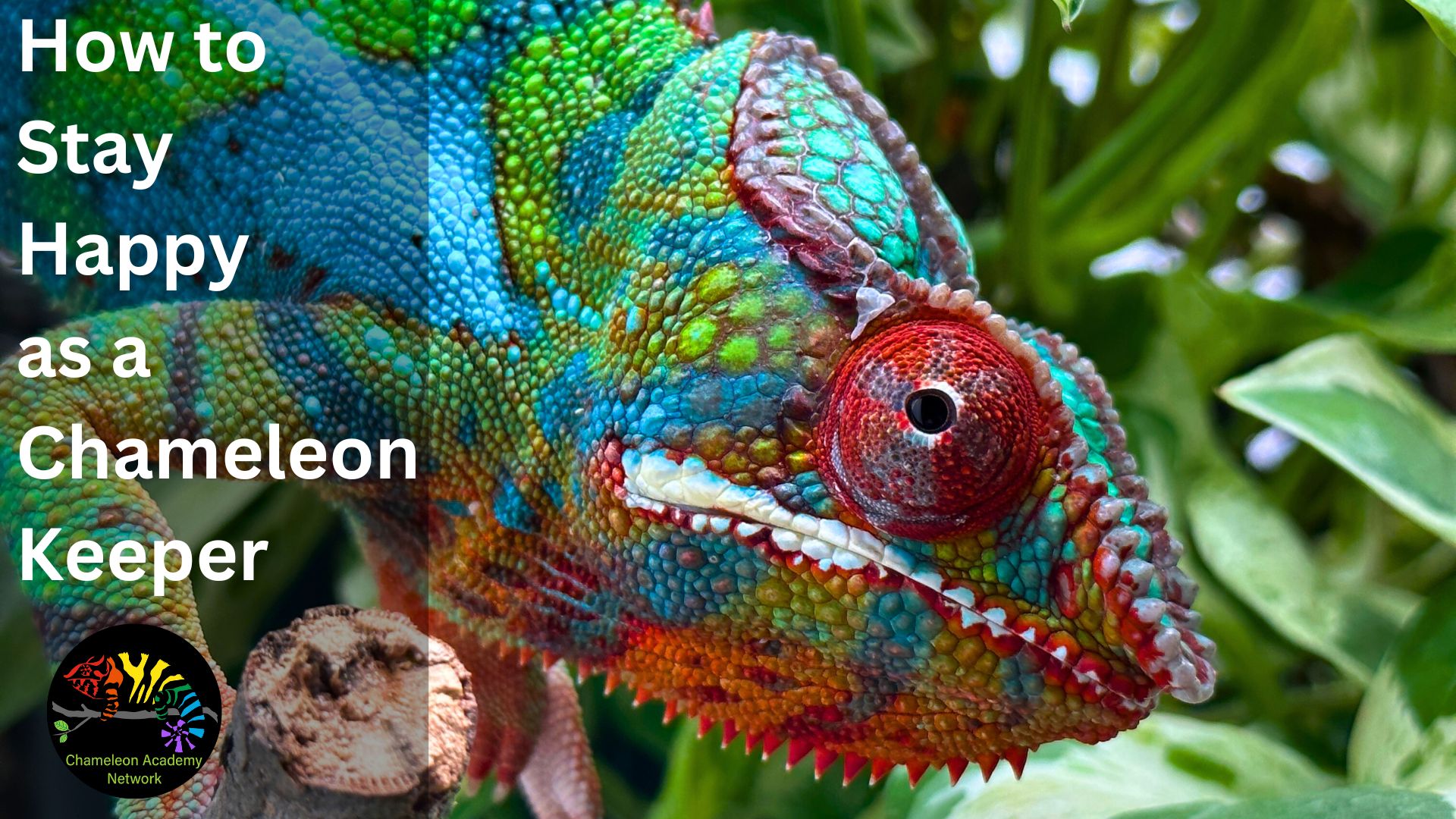How to Stay Happy as a Chameleon Keeper
It is very easy to get excited about chameleons. And just like everything else that excites us it is very easy to think that more of what is good is better! Today I am going to explore different ways to keep that excitement going long term.
Podcast Episode Player
Transcript (More or Less)
You all know the story. You fall in love with something and you get obsessed with it! Since you are here reading a magazine about chameleons you are the type of person to know how easy they can become an addiction! You get fascinated with chameleons, and then learn just how many different types of chameleons there are. And then you go down a rabbit hole of learning about nutrition, parasites, geography, biology and all sorts of other -ologies. You somehow convince your spouse to go on vacation to Madagascar and are trying to figure out how to convince them that “pardalis” would be a cool middle name for your new baby. Yep, typical story.
We find great joy in chameleons. This excitement often leads to expanding your collection and it is not uncommon for keepers to graduate into becoming chameleon breeders. Unfortunately, it is also not uncommon for keepers to get in over their head, become burned out, and have a stress level higher than enjoyment. But we love chameleons so much we don’t recognize the situation for what it is! Although people often do something enjoyable until it is no longer enjoyable and then try something else ad infinitum, there are ways to avoid burning out. There are ways to stay in the enjoyment phase even while expanding and gaining new chameleon experiences. And that is what I want to go over today. This isn’t your normal top five list as these things are subtle and only those into chameleons will really get their significance. But, if you keep these five things in mind you will maximize your enjoyment and minimize your stress. As someone who lives this day in and day out I can attest to their effectiveness! It isn’t easy backing into these things, but if you start with these in mind you will have a much greater sense of fulfillment in your chameleon experience!
Minimum Cage Size
My first suggestion is to get a cage that is at least 50% or 100% larger than the minimum cage size you find on the care guides for your selected species and gender of chameleon. If your minimum is listed as a 2’x2’x4’ cage then get a 3’x2’x4’ cage or a 4’x2’x4’ cage. Or go larger if you are handy with tools. This can be tricky as abnormal cage sizes are not readily available, but you also don’t have to do this right away. You can start with the minimum cage size. In fact, that might be easier because most of the voices on social media do not have experience with cages beyond the minimum. But, have it in your mind that you will be upgrading after the first year. This isn’t as disruptive or expensive as it sounds. You certainly can totally upgrade the cage to a high end larger cage, but you can also just add on another 2x2x4 screen cage to the one you already have to double the space. The logistics will be different in each situation. But let’s go into why.
Our challenge as the creators of our chameleon’s environment is to give them as many microclimates as possible. Microclimates are the small spaces that give us more or less of light, heat, humidity, or security. It can be 90 degrees under the heat lamp, but beneath the thick shade of all the plants it can be in the 70s. This is possible when you have space to work with. So the more space you have to work with the more microclimates you can offer your chameleon. They use these microclimates to sit in to regulate their comfort through out the day. So, the more space, the more they can take care of themselves. The more space and the more microclimates, the more behaviors you will see and the more enjoyable it will be. If you have room for one more cage next to your first cage consider expanding the cage for your original Chameleon instead of getting another chameleon. Yes, there are so many species that it is hard to choose. Yes, having another will be very cool, but the path to the dark side is the collector mindset. One more won’t be a total collapse of all that is good, but I want to warn you about the dynamic.
The collector mindset is when the chameleon world is like a candy shop to you. Lots of bright colors and dragon shapes all over and you want to collect them all. What happens as this goes on is that you only do the minimum size so you can fit more. And when you get more skilled and can effectively create cage interiors where you can keep a chameleon healthy in a smaller cage it allows you to fit more chameleons into the same space. This collector’s mindset is based on the excitement of adding names to your species list. And if you look at what your chameleon cages look like you will probably find the cages looking more and more sterile and easy to maintain. Please do not feel like I am judging you. I am pulling myself out of that stage and am in no position to judge anyone. I am warning you as to where the collector mindset leads. It is not a path to fulfillment. It always needs more.
The husbandry mindset, on the other hand, is excited to figure out how to make the chameleon’s environment higher and higher quality. Your collection includes adding on three different types of hydration and figuring out how to run the hydration cycles based on your chameleon’s individual needs. Your plans include how to give a bigger space or how to add an outdoor cage for the warmer weather months. And you have time to observe and deeply pay attention to your chameleon’s individual needs because you are not spreading your attention across ten chameleons in sterile enclosures. What the husbandry mindset does is obsess over the internal environment and the quality of life your chameleon has. Do you see how there is a very real mindset difference between the collector and husbandry mindset? It could also be termed the quantity and quality mindset. The collector mindset keeps you superficial with your chameleon while the husbandry mindset takes you deep into the art of chameleon herpetoculture. With the collector mindset you are proud of how many chameleon species you have kept or how well you can mass produce babies with your optimized facility. With the husbandry mindset you are proud with the beauty of your environment, the longevity of your chameleon, and the subtle behaviors you are seeing.
Now, realistically, there is no 100% collector and 100% husbandry mindset. I present them as absolutes to make it easy to describe and to practice for my application to the Sith university. But, in reality, we are all a mix of collector and husbandry. And if you recognize these forces playing on you then you can be in control of making sure that everything is in balance. So you can decide to add a female panther to your male panther and, at the same time, give them both a cage upgrade. Collecting is only a problem when it compromises quality of life. And that is for you to constantly keep watch on. Collecting has a strong dopamine response. It feels good. So just keep a watch on that drug and make sure you are in control and are making deliberate decisions that lead you where you want to go.
Keep only half of what you are able to keep.
So, how could you figure out what a good balance is between the excitement of collecting and the fulfillment of a quality life for your chameleon? That brings us to my second way to maintain happiness. Do an analysis of how many chameleons you could keep in the space, money, and time you have available and then make your maximum number of chameleons to be half that. The thing that sneaks up on chameleon keepers the most is the time it takes to properly care for them. You can automate, and I encourage that, but the more clever you get in having your set-up take care of itself the more detached you become. We generally gauge whether we can expand our chameleon keeping project with respect to whether we have enough money or do we have enough space to put in another minimum sized cage. But I am going to raise a big flag here and say you need to jealously guard your time. Even if it it just a little bit more, those little bit mores add up. And we think it is no problem to just add another chameleon. The additional time is immaterial. And this, in a vacuum is correct, but it is not hard to find breeders and even keepers who spend their entire free time taking care of all the chameleons. Now, this may be the joy for some people. So don’t waste your time judging what other people are doing. Figure out how much time you have during the day or week and how many chameleons you could take care of during that time. And then don’t let the number of chameleons you keep go above half that number. This will give you time to sit, enjoy, and engage in deeper learning.
Indoor/Outdoor cages for your chameleon.
So, with half your time spent caring for your chameleon you have half your time to consider how to increase quality of life. One thing that could do wonders for your chameleon is outdoor time. And I do not mean just taking the indoor chameleon cage and putting it outdoors. That is a quick way to kill the plants, the chameleon, or both. But the benefits of natural, unfiltered sunlight are indisputable. The natural ebb and flow of humidity and the gentle breezes are magic for chameleons when they have the ability to regulate their time in the sun or shade. The best situation you can create for your chameleon is to have both an outdoor and indoor cage. Most everything out there describes an indoor cage. An outdoor cage would be a large, cage around 4’ x 4’ and 7’ tall heavily planted, and sitting on bare soil. I go over outdoor cage husbandry in some other podcast episodes so refer to those to be able to put one together. Even if you can only use it a short time during the summer an outdoor cage will be a significant bump up in your chameleon’s health.
Breeding? Keep only four baby chameleons.
Breeding your chameleon is a next step many people take. Even if they only do it once for the experience breeding, done wrong, can be a deeply upsetting experience. The huge problem with breeding chameleons is that the babies do not like to be kept with each other and will passively aggressively bully and compete with each other. This means they should be separated for proper husbandry. And that is a lot of work. This is what I mean, housing the babies is the hardest part of raising chameleons. Having one cage space for each baby can get expensive, will take up a great deal of space, and eat up a great deal of time. The reason why so many breeders raise babies in a bin together is because it is much more convenient. They have developed skills to know who to separate when. And this is a constant judgment process you must go through or else you may will come home to damaged bodies from being bitten, tail ends nipped off, and smaller ones growing more and more slowly due to being intimidated by the bigger ones.
So, how can you experience the joy of breeding without taking on this enormous infrastructure building and time commitment? It is simple. To have a good experience breeding for the first time I suggest finding someone nearby that can take newly hatched babies and you keep only four. And I don’t mean family and friends or someone from the classifieds. I mean an experienced member of the chameleon community who is local and has experience raising hatchling chameleons. If you started breeding with the intention of making money are are now appalled that I would suggest letting someone else take away some of your golden eggs, allow me to suggest that you consider the second clutch your batch of golden eggs that will retire you early. Once you have gone through the first clutch with only the small amount you know you can handle you will have learned what you need to do to raise up a baby and you can multiple that by 30 and be more ready for the next clutch. You don’t need to go through the rough first clutch that most people do to learn how to make the next clutch a success. And if you are just wanting the experience of breeding, incubating, and raising up hatchlings it is so much nicer to raise up four hatchlings while learning rather than 30. I own the Dragon Strand chameleon caging company. Have you ever seen these nursery cages where you fit six to eight to a bakers rack? I invented those and I can fill my walls with as many nursery cages as I want. And, honestly, I still prefer to raise up only four hatchlings. And this is for the exact same reason as I said to expand the quality of your husbandry instead of expanding the number of chameleons. The greater the number you are working with the more diluted your attention and the more homogenous and simple each cage husbandry has to be. You only have X amount of time and you either spread that over 30 or spread that over four. Remember, my goal with this episode is not to tell you how to be a successful retail breeder who is able to produce a couple hundred panther a year. My goal in this episode is for you to maintain enjoyment and happiness in keeping chameleons. One of the biggest transitions a chameleon keeper goes through is when they start thinking like a breeder. You will see your thoughts go from individual to multiples. It goes from absolute best to most efficient application over multiple cages. It is a different mindset and it leads you down a business type path. Maybe the corollary to this point is to not let yourself slide into the thought that breeding will be a natural expansion of your growth in chameleon keeping. That used to be what we all thought. And 30 years ago it was true. There was so much we had to learn about breeding to establish our foundation of knowledge. But that was then. Times are totally different. Breeding panther chameleons or veiled chameleons is a recipe. You just have to do a handful of them to get the full benefit of that experience. Going into breeding is not the cash cow you think it is. If you go down that road then you have decided to replace doing this for enjoyment to doing this for business and your focus will totally change. If that is your path then do so with eyes wide open. But that is a different episode. This episode is how to maintain enjoyment in your chameleon keeping hobby and getting into breeding can be the end of that happiness. You can have the breeding experience and maintain the initial enjoyment if you limit the babies you are raising to a small and manageable number.
Now, I imagine there are many confused people out there because this is the first time I have suggested this publicly. It is a new concept for many people. This means that you may have to do some explaining when looking for people willing to take hatchlings off your hands. But since you have 6 to 9 month incubation period you can start right after the eggs were laid in looking for someone to help you out. Just don’t get caught up in thinking you need money for this. You are either doing this for money, in which case you should get the proper infrastructure and be a serious breeder, or else you should prioritize your personal experience and just find someone who is experienced and willing to invest in raising them up themselves.
If you are dealing with a live bearer then the situation is the same except for you don’t have half a year to plan. And if you are surprised by babies you don’t even have the time to think about it like we are doing now. The Jackson’s Chameleon Community Facebook group is often busy trying to help people navigate surprise babies
In review, only keep the babies that you have time to spoil. Four is a good number. You would only need to set up four baby cages. I like using 16”x16”x30” cages or, better yet to hold them until 6 months old I use 18” x 18” x36” cages.
And, finally, my fifth suggestion for keeping happiness in chameleon keeping is to breed at least one feeder insect. The easiest to look into are dubia roaches, or an equivalent species if your area won’t let you keep dubia. But you can also try super worms, black soldier flies, or silkworms depending on what you have available as far as land or mulberry trees.
The purpose for this is two fold. First, learning about taking care of a feeder is a novelty and challenging. And you get to see the satisfaction when your chameleon enjoys a special treat that you raised up yourself and know it is nutritious because you fed it yourself! It also gives you a buffer against not being able to get feeder shipped in due to heat, freezing, or natural disaster. Those of us who raised feeder insects skated through freezing winters where everything shipped arrived dead or the blazing summers where everything shipped arrived dead or during the covid lockdowns where nothing was shipped at all. I had dubia and super worms going and so, although I rationed them out, none of my chameleons went hungry. If you only have a couple chameleons you may have the problem of over production, but here is where it is a good thing to start thinking with a business mindset. You do not want to slow production so just sell the excess either to chameleon people or on the local classifieds to any reptile keeper around. You would be surprised at how much easier it is to make money raising roaches than it is to raise chameleons.
This is a very fun project to do with kids as well and can easily turn into a fascination. Once you have had success with dubia roaches how about trying some isopods. Those are the pill bugs you played with as a kid. And once you find out how many different varieties of isopods there are you can easily get sucked up into the isopod collecting world. I have some isopod colonies and it is strangely therapeutic to spend time looking for the isopods. And there are some fascinating varieties. And so if you have that nature of a collector, feed it with isopods instead of chameleons. It is just as fulfilling, but much cheaper and the care is much easier!
So those are my thoughts. I have been keeping, breeding, and studying chameleons for many decades. But I have also been studying the community and the entire community is affected by the trends or the things that people are bragging about. Back in the 90s is was all about how many species were on your species kept list. But today I am very happy to say that more and more people are taking pride in the quality of their husbandry.This is one of the most promising shifts in the history of chameleon keeping. And I don’t think it is a coincidence. It is the natural order of things. We first learn how to keep them alive. We then learn how to reliably breed them. And then we start turning our thoughts to how to care for them the best possible way. And this leads us to quality of care. But this isn’t a progression you have to make as an individual. That is the community’s progress. You starting now means you don’t have to figure out how to keep them alive. Just follow the instructions. You don’t have to breed a chameleon to consider yourself an expert. Now breeding a panther chameleon, at least, is relatively simple. Sure, it takes a lot of work and you do need to build skills to do it, but it is not a mystery. We know how to do it. It is an advanced recipe, but it is still a recipe today. So there is no reason for you to have to prove anything by breeding chameleons. It can be for enjoyment if you decide to do it at all. But we are at the point where we are turning our eyes away from sterile enclosures and creating beautiful environments where we watch heat, humidity, UVB, and hydration. In today’s community the bragging is in the creation of the environment. And the very cool thing about that is that you can stay on the path of enjoyment and be a full participant in the stage the chameleon community is in right now.
I want to thank you very much for joining me. I hope this insight helped you feel good about choosing to spoil your one or, okay, few, chameleons instead of expanding to the limits of your capabilities.I also hope you enjoyed the experience of listening to chameleon community topics. If you would like to enjoy a semimonthly electronic magazine I invite you to sign up for the Chameleon Academy Journal on the chameleonacademy.com website. When you do you will get a monthly newsletter where every other month you will receive a link to a full digital magazine about what is going on in the Chameleon Academy world. It is free to sign up. This publication is supported by affiliate links and so all you have to do is purchase UVB bulbs, foggers, or bioactive soil through the links you find in the magazine and that is all it takes! Essentially, by doing that you get a free chameleon magazine that is paid for by Amazon or The BioDude. Not a bad deal! By the way the coupon code for the bioddude is Chameleon10. Use that on your checkout and you get 10% off of most items on the website. It does’t apply to cages, but most everything else. Most importantly, it applies to the T5 UVB bulbs, both 6% and 12% and the 36 quart bags of Terra Firma Bioactive soil. That is the stuff I use and am very happy with. And the UVB bulbs? You know how valuable it is to have those before you need them and then find you are in an inventory slump. Snag those now and have them ready. The coupon code is Chameleon10 for thebiodude.com.
Thank you very much for joining me here. And I’ll see you next time












